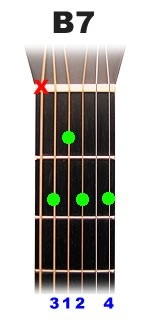The Open B7 Chord
Once you become more familiar with all these shapes, you'll find that you can begin to use bits and pieces of all of them and use them as moveable shapes, chunks of music that can be moved up and down the fretboard, changing pitch and name while still retaining their original flavor ... ▼
There is one more important open chord to mention: the open B7. It shows up often in tunes that are in the key of E, which is probably the most well loved of guitar keys, and this stand-alone shape is the most commonly used shape for this chord. I didn't include it in the first batch of open 7th chords because it has no plain old major counterpart. You can just learn the finger positions for it by looking at the diagram below, but I think it would be a good idea to watch the short movie above.
You'll see that it's really a C7th chord—which you learned earlier on—moved down in pitch one fret and tweaked a little bit. The more you can relate all these shapes to the original CAGED shapes the better. The quickest way to take the mystery out of guitar chords is to always see them as variations of those five original shapes. So, even though this B7th is a stand-alone chord, a one of a kind, it does in fact come from the C shape, even if it's not obvious at first.
The open B7th chord
The green dots show you where to put your finger tips. The red crosses mean 'Don't pluck/play this string'. The blue numbers indicate the best left hand fingers to use.
1 = index; 2 = middle; 3 = ring; 4 = pinkie.


Join Our Free Trial
Get started today before this once in a lifetime opportunity expires.
